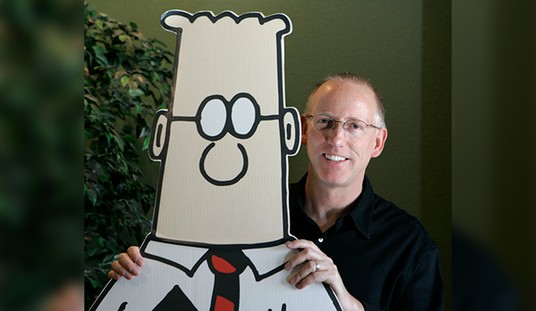Pauline Kael was among the first critics perceptive enough to spot what a huckster Michael Moore is (unlike Rex Reed), and her 1989 review of the film has been reprinted here.
Back when I was a film junky, I also remember reading an article in England’s Sight and Sound magazine (hardly a bastion of conservatism) that exposed many of the lies in that film as well, which put Moore on the map. Not the least of which was the film’s premise: Moore wore a silly cardboard cartoon “PRESS” badge whenever he visited GM, thus ensuring that he’d never meet with Roger Smith–because if he did, there’d be no movie.
(Via Terry Teachout.)
Update: The blog post with Kael’s review has been deleted, but curiously enough, it’s also been reprinted–in English–in a French Web forum devoted to film that Google spidered. Here’s the text, before that too vanishes:
Roger & Me
By Pauline Kael
I’ve heard it said that Michael Moore’s muckraking documentary Roger & Me is scathing and Voltairean. I’ve read that Michael Moore is “a satirist of the Reagan period equal in talent to Mencken and [Sinclair] Lewis,” and “an irrepressible new humorist in the tradition of Mark Twain and Artemus Ward.” But the film I saw was shallow and facetious, a piece of gonzo demagoguery that made me feel cheap for laughing.
Roger is Roger Smith, the chairman of General Motors, who, in Moore’s account, closed eleven GM plants in Flint, Michigan, in 1986 (despite big profits), laid off thirty thousand workers, and set up plants in Mexico, where the wage rate was seventy cents an hour. In the film, he’s directly responsible for bringing about the city’s (unconvincingly speedy) deterioration. Flint, GM’s birthplace, is also Michael Moore’s home town, and Moore, a journalist, previously inexperienced in film, set out, with a camera crew, ostensibly to persuade Roger Smith to come to Flint and see the human results of his policies. This mock mission is the peg that Moore hangs the picture on: he pursues Roger Smith over a span of two and a half years, from February, 1987, to August, 1989. Moore, who directed, produced, and wrote the film, and is its star, has defined his approach: “I knew the theme would be ‘looking for Roger’ and showing what was happening in Flint during this time period.”
What happens is that Moore, a big, shambling joker in windbreaker and baseball cap, narrates his analysis of the ironies and idiocies of what’s going on, and deadpans his way through interviews with an assortment of unlikely people, who are used as stooges, as filler. He asks them broad questions about the high rate of unemployment and the soaring crime rate, and their responses make them look like phonies or stupes; those who try to block his path or duck his queries appear to be flunkies. Low-level GM public-relations people make squirmy, evasive statements; elderly women on a golf course are confused as to what’s wanted of them; visiting entertainers are cheery and optimistic; Miss Michigan, who is about to take part in the Miss America Pageant, tries to look concerned and smiles her prettiest. What does Moore expect? Why are these people being made targets for the audience’s laughter? The camera makes brutal fun of a woman who’s trying to earn money as an Amway color consultant, and it stares blankly at a woman who’s supplementing her government checks by raising rabbits. (For a minute or two, we seem to be watching an Errol Morris movie.) Moore’s final jab is at a woman with a Jewish name, whose job promoting the attractions of the city has been eliminated. He asks her what she’s going to do next. When she says she’s going to Tel Aviv, Moore seems to be drawing the conclusion that the rats are deserting the ship; something distasteful hovers over the closing credits.
Moore is the only one the movie takes straight. (Almost everybody else is a fun-house case.) This standup crusader appears to be the only person in town who’s awake to the destruction of what used to be a thriving community. And we in the audience are expected to identify with his puckish sanity. The way he tells it, the people who run the town are incompetent twerps. (That’s always popular with movie audiences.) He reports that the civic leaders have been thinking about solutions for the decay of the city and have come up with lamebrained fantasy schemes to attract tourism: a Hyatt Regency hotel and convention center; AutoWorld, a theme park; the Water Street Pavilion, a mall. The three projects are actually built; roughly a hundred and fifty million dollars is poured in, and all three are fiascoes.
I had stopped believing what Moore was saying very early; he was just too glib. Later, when he told us about the tourist schemes, I began to feel I was watching a film version of the thirties best-seller A Short Introduction to the History of Human Stupidity, and I began to wonder how so much of what was being reported had actually taken place in the two and a half years of shooting the film. So I wasn’t surprised when I read Harlan Jacobson’s article in the November-December, 1989, Film Comment and learned that Moore had compressed the events of many years and fiddled with the time sequence. For example, the eleven plant closings announced in 1986 were in four states; the thirty thousand jobs were lost in Flint over a period of a dozen years; and the tourist attractions were constructed and failed well before the 1986 shutdowns that they are said to be a response to. Or let’s take a smaller example of Moore at play. We’re told that Ronald Reagan visited the devastated city, and we hear about what we assume is the President’s response to the crisis. He had a pizza with twelve unemployed workers and advised them to move to Texas; we’re told that during lunch the cash register was lifted from the pizza parlor. That’s good for a few more laughs. But Reagan visited the city in 1980, when he wasn’t yet President–he was a candidate. And the cash register had been taken two days earlier.
Whatever the reasons for the GM shutdowns, the company had a moral and financial responsibility to join with government agencies and the United Automobile Workers in arranging for the laid-off workers to reënter the labor force. Moore doesn’t get into this–at least, not directly. Possibly he thought that he’d lose the audience’s attention if he did. Maybe he thought that it was implicit in the gimmick of his wanting to show Roger the damage the company has done, but it’s almost perverse of him to pretend that what’s happened is all Roger Smith’s fault, and to tell the story in cartoon form.
The movie is an aw-shucks, cracker-barrel pastiche. In Moore’s jocular pursuit of Roger, he chases gags and improvises his own version of history. He comes on in a give-’em-hell style, but he breaks faith with the audience. The picture is like the work of a slick ad exec. It does something that is humanly very offensive: Roger & Me uses its leftism as a superior attitude. Members of the audience can laugh at ordinary working people and still feel that they’re taking a politically correct position [242-245].










Join the conversation as a VIP Member